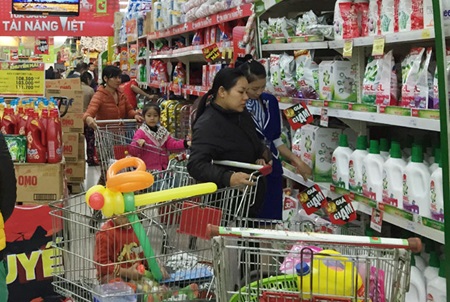Supermarkets tap into domestic retail sector
Supermarkets tap into domestic retail sector
The considerable potential of Viet Nam's domestic retail market is being actively promoted by large retailers looking to expand their businesses at a faster pace.

The Ministry of Industry and Trade said the modern retail model in Viet Nam accounted for a quarter of the national retail value. Viet Nam has 724 supermarkets, 132 shopping centres and hundreds of convenience stores. Most of these supermarkets and shopping centres are concentrated in large cities. Meanwhile, sale agents are mainly located in rural areas.
Given their great potential, foreign and local retailers had stepped up the development of their retail network nationwide, reported vnexpress.net, a local online newspaper.
VinMart, a retail brand of VinGroup, entered the local market in 2014. VinGroup plans to restructure 13 of the existing supermarkets of Ocean Mart this year after buying Ocean Mart from the Ocean Group last year and develop under the VinMart brand.
During the next three years, VinMart also expects to add 100 supermarkets and 1,000 convenient stores nationwide to its retail system via new investment projects or mergers and acquisitions (M&As) projects.
During the review quarter, movements were observed from both local and foreign retailers, according to the first quarter report on the Ha Noi property market of CBRE Viet Nam, one of the foreign property service providers in Viet Nam.
Vincom Retail aggressively expanded the Vinmart+ chain, including mini-supermarkets and convenient stores, while opening two new brands for the VinPro (electronics outlet) and VinDS (department store) in 2015, the CBRE report said.
Strong expansion was also reported from the Aeon Group (Japan) and two other retailers from Thailand (BJC and Central Group) via their partnership with local retailers, it said.
Emart, a South Korean retail group, plans to open its first trading centre, with a total investment of US$60 million in HCM City going forward.
Meanwhile, vnexpress.net quoted Hong Won Sik, general director of the Lotte Viet Nam Trading Centre Ltd Company, as saying that the company had promoted investment in its retail system in Viet Nam because the local retail market held great potential, especially in the rural areas.
This year, Lotte Viet Nam was scheduled to open three more supermarkets in Can Tho, Nha Trang and HCM City, he said. By 2020, the company would have 60 trading centres in Viet Nam and would have become one of the leading retailers in the nation.
In HCM City, the retail market is also expected to expand to the secondary and suburban areas faster than the central business districts (CBDs) due to growing demand for goods from a large and expanding population, the Savills Viet Nam's first quarter report on the HCM City property market said.
From 2015 onwards, the total future supply in the secondary area would account for 57 per cent, followed by the suburban areas, with 27 per cent and the CBDs at 16 per cent, the report said.
A retail manager from a foreign company in Viet Nam said the retail market would see more intense competition in the future. Therefore, new businesses in the market would find it hard to compete with existing retailers if they did not have great potential.
If the existing large retailers did not restructure themselves to boost market share, the new retailers would capture their market share, the retail manager said. In the future, the trend of M&As in the retail sector would continue and e-commerce in the sector would also develop further.
In a recent consumer survey conducted by CBRE, where 1,000 consumers aged 18 to 64 years old, were interviewed in Ha Noi and HCM City, a quarter of the respondents said they expected to shop less often at a store.
Around 45 to 50 per cent of the respondents said they would shop online via a desktop or laptop or smartphone or tablet more often than they did now.
It was surprising that a greater proportion of consumers (69 per cent) aged from 55 to 64 years actually thought they would use their smartphones or tablets more frequently to buy non-food items.
Although the outlook for the brick-and-mortar retailer format still remains upbeat, shopping centre operators should be aware of the challenges posed by online retailers, CBRE said. This would be crucial for shopping centre management and related areas, such as marketing.
It was suggested that retailers and landlords should also take advantage of this trend and do more online selling and advertising via social media and their well customised "Business to Customer (B2C)" websites.
In addition, CBRE recommended that landlords adapt their strategy to boost both e-commerce and offline business activities by leveraging "big data", which can track levels of consumer engagement, implement Online to Offline (O2O) strategies, and create simple and useful applications for those who wanted to shop via their smartphone or tablet.


















